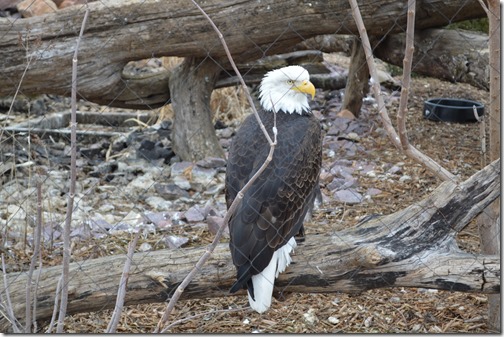The most pleasant surprise of being in Iowa this week has been seeing one bald eagle in the sky, two bald eagles at the National Mississippi River Museum & Aquarium, and three eaglets, visible on web cams, emerging from their shells this week in Iowa tree eyries (nests).
One of two bald eagles at the National Mississippi River Museum & Aquarium in Dubuque, Iowa.
As I was touring a paddleboat cruise ship at Port of Dubuque this week, a bald eagle circled high overhead, above the Mississippi River. And I had left my telephoto on the bus so no decent photo. Another travel writer captured a great image on his Nikon.
Then, about 30 minutes later, while touring the National Mississippi River Museum & Aquarium, one of the outdoor exhibits between the two main buildings holds a pair of bald eagles. They are old eagles, about 20 years of age, who were a breeding pair from the San Francisco Zoo. The unfortunate reality is they were born in captivity and therefore never acquired the natural survival skills necessary for release into the wild. On the other hand, the bald eagle breeding program at San Francisco Zoo helped repopulate California with bald eagles. The zoo’s bald eagle breeding program was so successful that breeding other endangered eagle species worldwide are part of the zoo’s activities.
Conservation Success Story
At the time the American bald eagle was designated the national bird of the United States in 1782, it is estimated there were over 25,000 breeding pairs in the region of the lower 48 states. The bald eagle appears in the official seal for the President of the United States holding 13 arrows and 13 olive branches in its talons.
American bald eagle population had declined to about 10,000 breeding pairs by the 1950s and were placed on the endangered species list in 1967 at a time when there were estimated to be only 400 breeding pairs in the lower 48 states. Alaska has about 50% of the world’s bald eagle population and more bald eagles than all the lower 48 states combined.
Bald eagles primarily eat fish and animal carcasses. Pesticides like DDT resulted in thin egg shells that could not survive the weight of a 9 to 12 pound adult eagle nesting on them. The combination of DDT pesticide concentration and lead pellets in animal carcasses had a deleterious impact on the American bald eagle. Loss of tree habitat and power lines were another factor affecting bald eagles.
In California, breeding pairs had dropped from 400 to 35 pairs from the 1950s to the 1970s. San Francisco Zoo’s bald eagle breeding program began in 1985. More than 100 bald eagles from the SF Zoo breeding program have been released in California. In 2005, the population in California had grown to more than 200 breeding pairs. Similar bald eagle breeding programs have occurred at locations in many states.
In June 2007 the bald eagle was removed from the endangered species list when the number of breeding pairs were estimated to be over 10,000 across the lower 48 USA. The American bald eagle is one of the conservation success stories of species regeneration.
American bald eagles living in retirement at the National Mississippi River Museum & Aquarium in Dubuque, Iowa arrived from San Francisco Zoo in late 2012 as a permanent feature of the Mississippi River Plaza at Port of Dubuque. Video.
The good news is the population has rebounded to over 10,000 pairs today. (Bald eagle sound effect). In Iowa 210 active nests were found in 81 counties during 2007. This is far and above the original goal of 10 active nests in the state. These numbers are only estimates because the Iowa Department of Natural Resources no longer has the staffing to monitor many of these nests as well as search for new nests. Nest monitoring is left mostly to concerned citizens and volunteers. If you or anyone else you know finds a bald eagle nest, report it to Iowa Department of Natural Resources Wildlife Diversity Program.
Eaglet Hatching Season in Iowa
On my first day in Iowa there were two bald eaglets born April 2 and a third eaglet appeared April 3 on web cams when they emerged from their shells in two different eyries in two different parts of the state near Davenport and Decorah.
Decorah, Iowa has an eagle eyrie (nest) webcam known worldwide with over 287 million views to date. This year the nesting pair of eagles had three eggs. The first egg appeared in February when the weather was –20F and the nest covered in ice. The brutally cold and snowy winter conditions in Iowa threatened the survival of the eggs.
Bob Anderson, director of the Raptor Resource Project, brought road kill carcasses to the Decorah nesting site so the eagles would not need to travel far from the nest to hunt. Maintaining a 100-degree temperature for the eggs over the 35-day incubation period before the eaglets hatched was a joint effort between both eagle parents. Eagle pairs mate for life and work together to care for eggs and raise eaglets. Bald eagles grow four to five years before the distinctive white-feathered head develops on the sexually mature adults.
On Wednesday, April 2, the Decorah pair of eagles saw their first eaglet emerge from its shell. On Thursday evening, the second of three eggs saw an eaglet emerge. It has been amazing this week to watch the visitor counter spinning like a slot machine as people logged onto the webcam site to view the eaglets.
No wonder. These eaglets are too cute!
Decorah eaglets born this week seen in a photo from the Raptor Resource Project Facebook.
The third eaglet may hatch any day now. Tune in and I hope you are as turned on as I have been this week learning about the life cycle of bald eagles while touring Iowa.






1 Comment
Comments are closed.